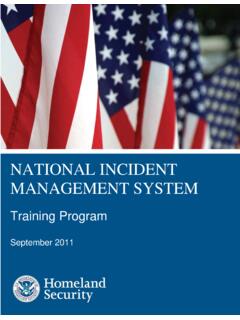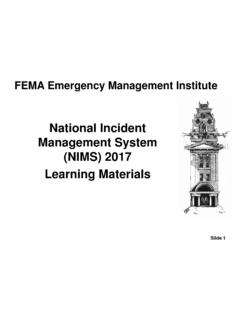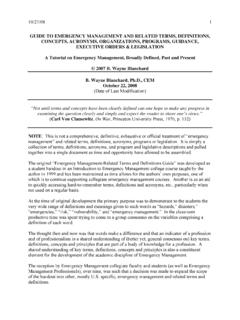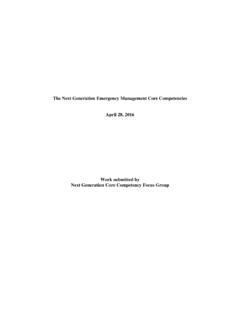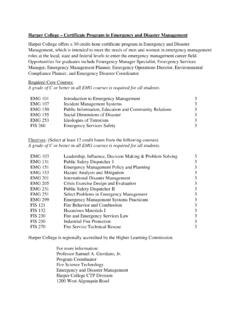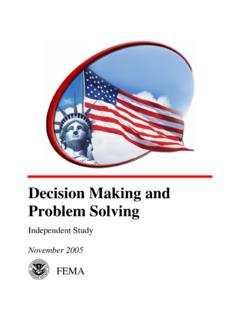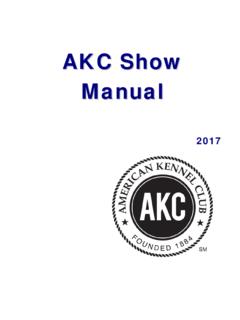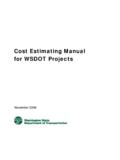Transcription of Special Events Contingency Planning - FEMA
1 Special Events Contingency Planning Job Aids manual March 2005. FEMA. IS-15: Special Events Contingency Planning Job Aids manual TABLE OF CONTENTS. Acknowledgements .. 1. Introduction Preface .. 1. Background .. 2. Scope .. 3. Synopsis .. 4. Chapter 4. Chapter 1: Pre-Event Planning 1-1. Definition of Special Event and Mass Gathering .. 1-1. Planning Meetings for Special Events /Mass Gatherings .. 1-2. The Planning 1-3. State and Federal Roles in Terrorism Incident Prevention .. 1-4. Crowd Types .. 1-9. Crowd Composition .. 1-10. Crowd Catalysts .. 1-11. Critical Crowd Densities .. 1-11. Crowd Throughput Capacities .. 1-12. Chapter 2: Event Operational Considerations 2-1. Hazard 2-1. Contingency Plans .. 2-4. Structural 2-5. High-Profile/Controversial Events .. 2-9. Spectator Management and Crowd Control .. 2-10. Traffic and Transportation.
2 2-16. Public 2-21. Medical Care .. 2-34. Guide to the Provision of Medical Aid .. 2-40. Environmental Concerns .. 2-44. 2-46. Camping .. 2-46. Hazardous Materials (HazMat) .. 2-47. Chemical, Biological, Radiological, Nuclear, Explosive (CBRNE).. 2-48. Chemical .. 2-49. 2-50. Radiological .. 2-50. Nuclear .. 2-50. March 2005 Page i IS-15: Special Events Contingency Planning Job Aids manual TABLE OF CONTENTS (CONTINUED). Chapter 2: Event Operational Considerations (Continued). Explosives .. 2-51. Electrical Utility Coordination Requirements .. 2-54. Fire 2-54. Communications Systems .. 2-55. Rumor 2-57. Occupational Health and Safety .. 2-57. Alcohol, Drugs, and Weapons .. 2-58. Security .. 2-59. Lost-Child and Meet Me Locations .. 2-62. Information Center .. 2-63. Plan for Murphy's Law .. 2-63. Chapter 3: Incident Command and Control 3-1.
3 Incident Command System (ICS) .. 3-1. Roles and Expectation .. 3-4. Incidents Occurring During a Special Event .. 3-9. Transfer of 3-10. Unified Command .. 3-11. Unified Command 3-12. Multi-agency Coordination Systems .. 3-13. Public Information 3-16. Federal and State Resources .. 3-23. Chapter 4: Additional Planning Considerations for Specific Events 4-1. Power Boat Races and Similar Aquatic Events .. 4-1. Automobile and Similar 4-2. Air Shows and Displays .. 4-5. Fireworks and Pyrotechnics .. 4-6. Laser Displays .. 4-7. Spontaneous 4-7. Events Involving Pre-Teen and Early Teen Audiences .. 4-8. Page ii March 2005. IS-15: Special Events Contingency Planning Job Aids manual TABLE OF CONTENTS (CONTINUED). Chapter 5: Post-Event Actions 5-1. Demobilization .. 5-1. Post-Event Analysis Meeting .. 5-1. After-Action Report.
4 5-2. Appendix A: Job Aids Appendix B: References and Bibliography Appendix C: Glossary of Terms March 2005 Page iii IS-15: Special Events Contingency Planning Job Aids manual ACKNOWLEDGEMENTS. The following agencies are gratefully acknowledged for their input to this manual : Federal Emergency Management Agency FEMA National Fire Academy Virginia Department of Health New York State Police City of Keene Police Department, New Hampshire Sarasota Fire Department, Florida Washington, DC Fire and EMS Department Miami-Dade Office of Emergency Management, Fire-Rescue Department, Florida Cabin John Park Volunteer Fire Department, Maryland Marion County Emergency Management, Indiana Massachusetts Emergency Management Agency Weber County Emergency Management, Utah Washington Office of Emergency Preparedness Utah Division of Comprehensive Emergency Management Columbia South Carolina Public Works American Public Works Association Acknowledgement is also made of the manual , Safe and Healthy Mass Gatherings: A.
5 Health, Medical and Safety Planning manual for Public Events , prepared by Emergency Management Australia, and of the paper, Emergency Preparedness Guidelines for Mass, Crowd-Intensive Events , prepared for Emergency Preparedness Canada by James A. Hanna, M. SC. March 2005 Page 1. INTRODUCTION. IS-15: Special Events Contingency Planning Job Aids manual PREFACE. The purpose of this manual is the prevention of injury, suffering, or death that may occur as a result of poor Planning or preventable incidents at public Events . This manual is intended to provide guidance for the management of risks associated with conducting Events that involve mass gatherings of people and assist planners and organizers in making such Events safe and successful. Details of the development of the manual and other related matters are noted in the Background section of the Introduction.
6 The manual was sponsored, edited, and published by the Department of Homeland Security (DHS)/Federal Emergency Management Agency (FEMA). FEMA has prepared this manual for use by anyone Planning or conducting a Special event or mass gathering. This manual is intended to enable its users to ensure that adequate measures and systems are in place to prevent, reduce, and provide care for injuries, illness, and suffering that may occur. Many people, in addition to health personnel, contribute significantly to the success of a public event. Therefore, FEMA anticipates that this manual will be distributed to event promoters, managers, public and private organizations, emergency service personnel, government bodies, and any individual or organization that contributes to the Planning of Events . Wide distribution is encouraged, providing that individuals understand that the detailed contents of the manual are directed principally at managing the health and safety aspects of the event for all participants, officials, and spectators.
7 The manual is not intended to override any existing legislation or local emergency management procedures. Further, it does not seek to address the preparation of emergency response plans, but rather identifies the elements that should be considered by those responsible for Planning and conducting Events that attract large numbers of people. Local governments and emergency services should be approached for more detailed advice on other aspects of Planning and for the necessary permits and licenses required. March 2005 Page 1. IS-15: Special Events Contingency Planning Job Aids manual BACKGROUND. Throughout the United States, at any given time of year, there are festivals, concerts, fairs, sporting Events , and many other large and small Events that gather or have the potential to gather large crowds. Under normal conditions, these Events go on with few or no problems.
8 When something goes wrong, however, either as a result of a natural hazard or a man- made hazard, then local emergency management becomes involved. These mass gatherings are also potential targets for terrorists. Multiple deaths and injuries at large public Events have occurred consistently and over a wide spectrum of countries and types of Events . Certain highly competitive sports Events , particularly soccer, and rock concerts and festivals tend to produce spectator-generated incidents, while air shows and auto races tend to produce more participant-generated occurrences. In some instances, advanced assessment of, and Planning for, these Events failed to occur, or when they did, they failed to identify the potential for disaster, or mitigating or coping strategies for a major incident. With this in mind, FEMA conducted a focus group workshop during which participants discussed real pre-event Planning problems for an upcoming event.
9 The workshop focused on a number of major areas, which, either singularly or collectively, have intensified the problems inherent in mass crowd-intensive Events . These issues included such aspects as physical layouts, spectator management, public safety, public health, and medical care. The workshop was not geared toward large, often national Events ( , Incidents of National Significance, National Special Security Events , though the Planning principles still apply), but toward the more routine Special Events that communities host, such as parades, fairs, concerts, and air shows. The participants focused on the impact that an event, a non-routine activity, would have on a community's resources. They placed emphasis not on the total number of people attending, but rather on the community's ability to respond to the exceptional demands that the activity would place on response services.
10 The purpose of having a pre-event plan in place is to reduce response times and better enable agencies to improvise because they have discussed contingencies beforehand. A. pre-event plan defines roles and responsibilities in advance and creates ownership of potential problems for agencies that are involved in the process. On February 28, 2003, the President issued Homeland Security Presidential Directive (HSPD) 5, Management of Domestic Incidents, which directs the Secretary of Homeland Security to develop and administer a National Incident Management System (NIMS). This system provides a consistent nationwide template to enable Federal, State, local, and tribal governments and private-sector and non-governmental organizations to work together effectively and efficiently to prepare for, prevent, respond to, and recover from domestic incidents, regardless of cause, size, or complexity, including acts of catastrophic terrorism.

